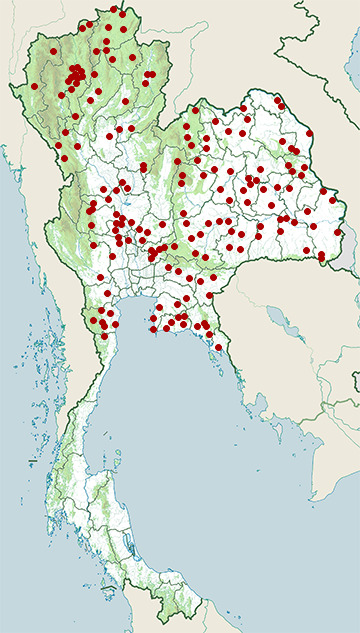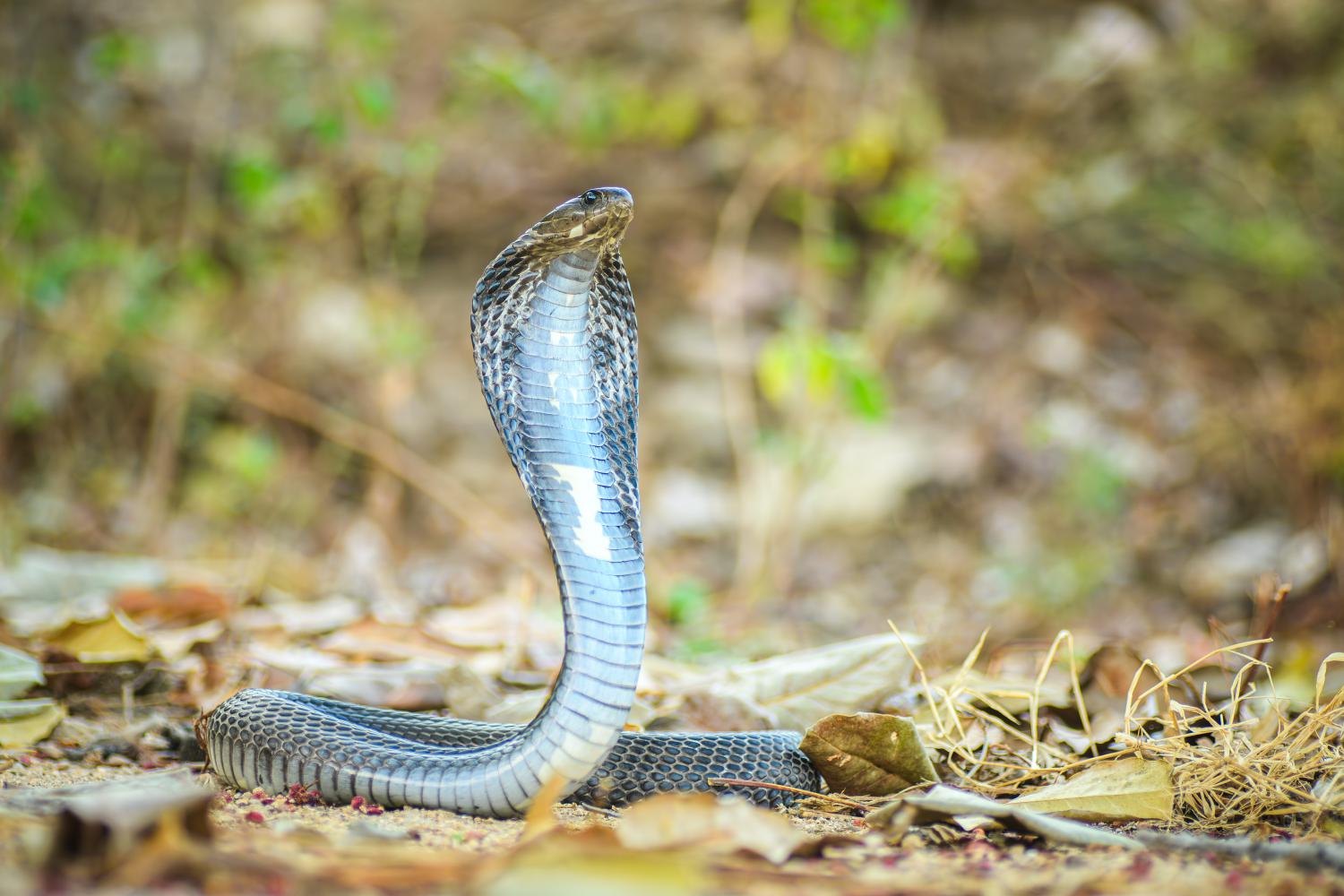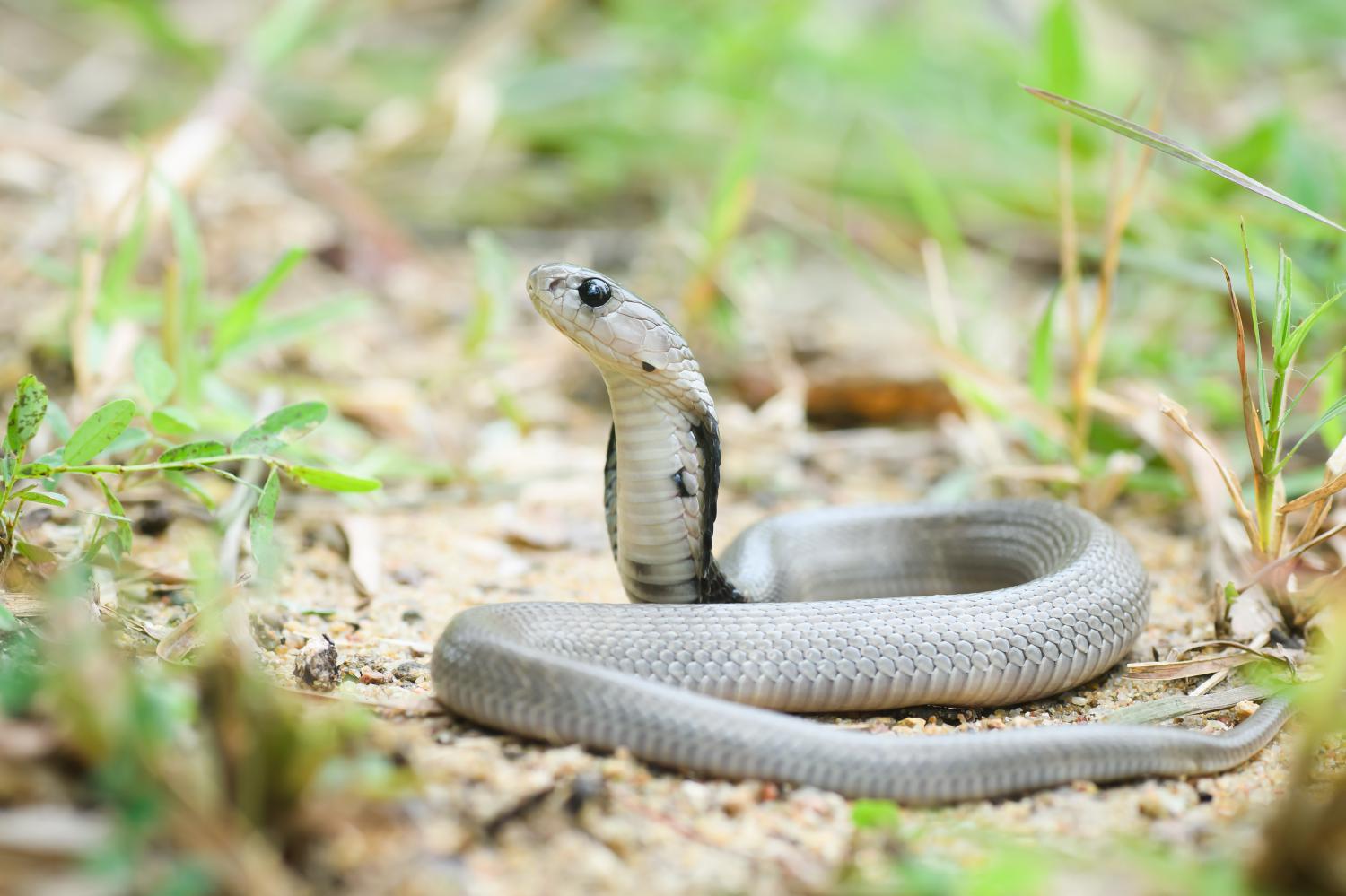Species of Thailand
Indo-Chinese spitting cobra
Naja siamensis
Josephus Nicolaus Laurenti, 1768
In Thai: งูเห่าสยามพ่นพิษ, ngu haow Sayam ponn phit
The Indochinese spitting cobra (Naja siamensis) (, pronounced: nguu hao) also called the Thai spitting cobra, black and white spitting cobra, Siamese spitting cobra, is a species of spitting cobra found in Southeast Asia.
Description
This is a medium-sized elapid, with a more slender build compared to most other cobras within the genus Naja. The body colour of this species is variable from grey to brown to black, with white spots or stripes. The white patterning can be so prolific that it covers the majority of the snake. The highly distinctive black and white colour phase is common in central Thailand, specimens from western Thailand are mostly black, whereas individuals from elsewhere are usually brown. The hood mark can be spectacle-shaped, irregular or missing altogether, especially in adults. Adults average between 0.9 to 1.2 m in length, and can potentially reach lengths of 1.6 m, although this is considered rare. Body mass for adults can be tends to be around 1, 600 grams.
This species should not be confused with the monocled cobra (Naja kaouthia), which has similar habitat, size and appearance. Another distinguishing feature is that this species is a "true spitter"; it readily spits venom, but rather than a stream of venom as seen with many other "spitting cobras", this species ejects a "mist" rather than a "stream". Further, the reported spitting range of this species is approximately 1 m, which is the lowest range of any of the spitting cobras. Although Wüster (unpublished) reports that N. siamensis readily spits and may have a longer range, closer to 2 m, which comes out in a stream.
Scalation
There are 25-31 scale rows around the hood, 19-21 just ahead of midbody; 153-174 ventral scales, 45-54 subcaudal scales, and basal pairs are sometimes undivided.
Taxonomy
Naja siamensis is classified under the genus Naja of the family Elapidae. It was first described by Austrian-born Italian zoologist Josephus Nicolaus Laurenti in 1768. The generic name Naja is a Latinisation of the Sanskrit word (), meaning "cobra". The specific epithet siamensis is derived from the word Siam or Siamese, which means "relating to or characteristic of Thailand or its people and language". This species was long confused with the monocled cobra (Naja kaouthia) and the Chinese cobra (Naja atra), and extensive variation in pattern and scalation contributed to this confusion. Detailed morphological and molecular analyses revealed it to be a distinct species during the 1990s.
Distribution and habitat
It is found in Southeast Asia, including Thailand, Cambodia, Vietnam, and Laos. May occur in eastern Myanmar but no records are known. It has been reported from Taiwan where it was released to the wild based on folklore Buddhist practices. It occupies a range of habitats including lowlands, hills, plains, and woodland. It can also be found in jungle habitat and it is sometimes attracted to human settlements because of the abundant populations of rodents in and around these areas.
Behavior and diet
It is a primarily nocturnal species. It shows variable temperament depending on the time of day it is encountered. When threatened during daylight hours, the snake is generally timid and seeks refuge in the nearest burrow. However, when the snake is threatened at night, it is more aggressive and is more likely to stand its ground, rear up and display its hood and spit out its venom. If spitting venom doesn't work, it will strike and bite as a last resort. When biting, this species tends to hold on and chew savagely. It usually feeds on rodents, toads, and other snakes.
Reproduction
The snake is oviparous. The female will lay 13-19 eggs 100 days after oviposition. Eggs will hatch after 48 to 70 days depending on the temperature of incubation. Offspring are independent as soon as they have hatched. Hatchlings are anywhere from 12 to 20 cm long and, because they possess fully developed venom delivery systems, should be treated with the same respect as adults. Some hatchlings can be as long as 32 cm.
Venom
Like most other spitting cobras, its venom is primarily a postsynaptic neurotoxin and cytotoxin (necrotizing or tissue-death). Like all cobras, this species shows variation in venom toxicity based on different factors (diet, locality, etc.). In a study of specimens from Thailand, the IV was 0.28 μg/g (0.18-0.42 μg/g). Fischer and Kabara (1967) listed a value of 0.35 mg/kg via IP route. Another study gave an range 1.07-1.42 mg/gram of mouse body weight. Bite symptoms include pain, swelling and necrosis around the wound. The bite of this snake is potentially lethal to an adult human. Deaths, which generally happen due to paralysis and consequent asphyxiation, mainly occur in rural areas where the procurement of antivenin is difficult.
If the snake spits venom into the eyes of an individual, the individual will experience immediate and severe pain as well as temporary and sometimes even permanent blindness.
Cases
In a national hospital based survey of snakes responsible for bites in Thailand, 10% of all dead snakes brought by snake-bitten patients were of this species (described as "Naja atra northern spitting cobra"). Neurotoxic signs (ptosis and difficulty in breathing) were observed in 12 of the 114 cases (10.5%). Local swelling and necrosis were common, but many of the patients were followed up for too short a time to allow precise assessment of the incidence of these effects. Swelling and necrosis, comparable in all respects with that following bites by N. kaouthia, in patients envenomed by N. siamensis in Ubon and Kanchanaburi in Thailand.
This article uses material from Wikipedia released under the Creative Commons Attribution-Share-Alike Licence 3.0. Eventual photos shown in this page may or may not be from Wikipedia, please see the license details for photos in photo by-lines.
Site notes
This species shows both nocturnal and diurnal behaviour.
Scientific classification
- Kingdom
- Animalia
- Phylum
- Chordata
- Subphylum
- Vertebrata
- Class
- Reptilia
- Order
- Squamata
- Suborder
- Serpentes
- Family
- Elapidae
- Genus
- Naja
- Species
- Naja siamensis
Common names
- German: Indochinesische Speikobra
- English:
- Indo-Chinese spitting cobra
- Siamese spitting cobra
- Black and white spitting cobra
- Thai spitting cobra
- Thai:
- งูเห่าสยามพ่นพิษ, ngu haow Sayam ponn phit
- งูเห่าอิสานพ่นพิษ, ngu haow Isaan ponn phit
- งูเห่าด่างพ่นพิษ, ngu haow dang ponn phit
- งูเห่าพ่นพิษสีน้ำตาล, ngu haow ponn phit see namdtan
- งูเห่าดำพ่นพิษ, ngu haow damm ponn phit
Conservation status

Vulnerable (IUCN3.1)
Photos
Please help us review our species pages if wrong photos are used or any other details in the page is wrong. We can be reached via our contact us page.
Range Map

- Bamnet Narong District, Chaiyaphum
- Ban Dung District, Udon Thani
- Ban Khai District, Rayong
- Ban Lat District, Phetchaburi
- Ban Mi District, Lopburi
- Ban Phue District, Udon Thani
- Ban Rai District, Uthai Thani
- Ban Tak District, Tak
- Bang Lamung District, Chonburi
- Banphot Phisai District, Nakhon Sawan
- Bo Thong District, Chonburi
- Borabue District, Maha Sarakham
- Bueng Bun District, Sisaket
- Bueng Khong Long District, Bueng Kan
- Bueng Na Rang District, Phichit
- Cha-Am District, Phetchaburi
- Chai Badan District, Lopburi
- Chiang Saen District, Chiang Rai
- Chom Phra District, Surin
- Chom Thong District, Chiang Mai
- Chonnabot District, Khon Kaen
- Chum Phuang District, Nakhon Ratchasima
- Dan Khun Thot District, Nakhon Ratchasima
- Doem Bang Nang Buat District, Suphan Buri
- Doi Saket District, Chiang Mai
- Fang District, Chiang Mai
- Hang Dong District, Chiang Mai
- Hankha District, Chainat
- Hua Hin District, Prachuap Khiri Khan
- Huai Kha Khaeng Wildlife Sanctuary
- Huai Thap Than District, Sisaket
- Kabin Buri District, Prachinburi
- Kaeng Khoi District, Saraburi
- Kaeng Krachan District, Phetchaburi
- Kaeng Krachan National Park
- Kantharalak District, Sisaket
- Kantharawichai District, Maha Sarakham
- Khai Bang Rachan District, Sing Buri
- Khanu Woralaksaburi District, Kamphaeng Phet
- Khao Chamao District, Rayong
- Khao Khitchakut National Park
- Khemarat District, Ubon Ratchathani
- Khlong Hat District, Sa Kaeo
- Khlung District, Chanthaburi
- Khok Samrong District, Lopburi
- Khok Si Suphan District, Sakon Nakhon
- Khon Buri District, Nakhon Ratchasima
- Khong Chai District, Kalasin
- Klaeng District, Rayong
- Ko Kha District, Lampang
- Kut Chum District, Yasothon
- Lam Plai Mat District, Buriram
- Lan Sak District, Uthai Thani
- Lat Yao District, Nakhon Sawan
- Li District, Lamphun
- Mae Ai District, Chiang Mai
- Mae Chai District, Phayao
- Mae La Noi District, Mae Hong Son
- Mae Poen District, Nakhon Sawan
- Mae Ramat District, Tak
- Mae Rim District, Chiang Mai
- Mae Sai District, Chiang Rai
- Mae Sot District, Tak
- Mae Wang District, Chiang Mai
- Makham District, Chanthaburi
- Manorom District, Chainat
- Muak Lek District, Saraburi
- Muang Sam Sip District, Ubon Ratchathani
- Mueang Buriram District, Buriram
- Mueang Chainat District, Chainat
- Mueang Chiang Mai District, Chiang Mai
- Mueang Chiang Rai District, Chiang Rai
- Mueang Kalasin District, Kalasin
- Mueang Khon Kaen District, Khon Kaen
- Mueang Lampang District, Lampang
- Mueang Lamphun District, Lamphun
- Mueang Loei District, Loei
- Mueang Lopburi District, Lopburi
- Mueang Maha Sarakham District, Maha Sarakham
- Mueang Mukdahan District, Mukdahan
- Mueang Nakhon Phanom District, Nakhon Phanom
- Mueang Nakhon Ratchasima District, Nakhon Ratchasima
- Mueang Nan District, Nan
- Mueang Pan District, Lampang
- Mueang Phayao District, Phayao
- Mueang Phrae District, Phrae
- Mueang Ratchaburi District, Ratchaburi
- Mueang Rayong District, Rayong
- Mueang Roi Et District, Roi Et
- Mueang Sa Kaeo District, Sa Kaeo
- Mueang Sakon Nakhon District, Sakon Nakhon
- Mueang Saraburi District, Saraburi
- Mueang Surin District, Surin
- Mueang Trat District, Trat
- Mueang Udon Thani District, Udon Thani
- Mueang Uthai Thani District, Uthai Thani
- Na Dun District, Maha Sarakham
- Na Kae District, Nakhon Phanom
- Na Klang District, Nong Bua Lamphu
- Nam Nao National Park
- Nam Yuen District, Ubon Ratchathani
- Nang Rong District, Buriram
- Nikhom Kham Soi District, Mukdahan
- Noen Maprang District, Phitsanulok
- Non Sung District, Nakhon Ratchasima
- Nong Bua Daeng District, Chaiyaphum
- Nong Han District, Udon Thani
- Nong Hin District, Loei
- Nong Khae District, Saraburi
- Nong Prue District, Kanchanaburi
- Nong Ruea District, Khon Kaen
- Nong Song Hong District, Khon Kaen
- Nong Sung District, Mukdahan
- Nong Ya Plong District, Phetchaburi
- Pa Sang District, Lamphun
- Pai District, Mae Hong Son
- Pak Chom District, Loei
- Pak Chong District, Nakhon Ratchasima
- Pak Phli District, Nakhon Nayok
- Phan District, Chiang Rai
- Phaya Mengrai District, Chiang Rai
- Phimai District, Nakhon Ratchasima
- Pho Sai District, Ubon Ratchathani
- Pho Thale District, Phichit
- Phon Phisai District, Nong Khai
- Phu Khiao District, Chaiyaphum
- Phu Khiao Wildlife Sanctuary
- Phu Pha Man National Park
- Phu Phiang District, Nan
- Phu Si Than Wildlife Sanctuary
- Phu Wua Wildlife Sanctuary
- Pong District, Phayao
- Prachantakham District, Prachinburi
- Prakhon Chai District, Buriram
- Rasi Salai District, Sisaket
- Sakaerat Environmental Research Station
- Sam Chuk District, Suphan Buri
- Sam Ngao District, Tak
- San Kamphaeng District, Chiang Mai
- San Sai District, Chiang Mai
- Sao Hai District, Saraburi
- Saraphi District, Chiang Mai
- Sattahip District, Chonburi
- Sawankhalok District, Sukhothai
- Selaphum District, Roi Et
- Si Bun Rueang District, Nong Bua Lamphu
- Si Racha District, Chonburi
- Sirindhorn District, Ubon Ratchathani
- Sung Noen District, Nakhon Ratchasima
- Suwannaphum District, Roi Et
- Takhli District, Nakhon Sawan
- Tha Mai District, Chanthaburi
- Tha Muang District, Kanchanaburi
- Tha Takiap District, Chachoengsao
- Tha Yang District, Phetchaburi
- Tham Pha Tha Phon Non-Hunting Area
- Thong Saen Khan District, Uttaradit
- Tron District, Uttaradit
- U Thong District, Suphan Buri
- Wang Chan District, Rayong
- Wang Saphung District, Loei
- Warin Chamrap District, Ubon Ratchathani
- Wat Sing District, Chainat
- Watthana Nakhon District, Sa Kaeo
- Wiang Pa Pao District, Chiang Rai
- Wiang Sa District, Nan
- Yang Chum Noi District, Sisaket
- Yod Dom Wildlife Sanctuary



